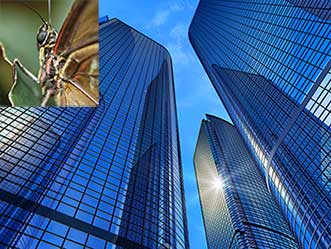It’s hard work cleaning the windows of skyscrapers. Dangerous, too.
But human window washers may one day be relegated to the same fate as the switchboard operator or bowling pin setter, thanks to a revolutionary type of smart glass.
Developed by a team of researchers from University College London (UCL) and the U.K.’s Engineering and Physical Sciences Research Council, the glass incorporates cone-shaped nanostructures — like those found on the eyes of moths. They are pencil-like structures that trap air and ensure that only a tiny amount of water comes into contact with the surface. When rain hits the glass, it forms spherical droplets that roll easily over the surface, picking up dirt, dust and other contaminants, and carrying them away. This is different from normal glass, where raindrops cling to the surface, slide down slowly and leave streaks behind.
 The nanostructures also diminish glare. And with the smart glass, the light reflected internally is reduced to less than 5 percent.
The nanostructures also diminish glare. And with the smart glass, the light reflected internally is reduced to less than 5 percent.
The smart glass also features a very thin (5 to 10 nm) coating of vanadium dioxide, which prevents thermal radiation from escaping in cold temperatures. During hot periods, the coating prevents infrared radiation from the sun from entering the building, keeping it cool inside. Because vanadium dioxide is cheap and abundant, it’s a more cost-effective alternative over silver/gold-based coatings used in current energy-saving windows.
“This is the first time that a nanostructure has been combined with a thermochromic coating. The bio-inspired nanostructure amplifies the thermochromics properties of the coating and the net result is a self-cleaning, highly performing smart window,” said Ioannis Papakonstantinou, who led the UCL researchers.
The windows could result in a reduction in heating bills of up to 40 percent, with insulating properties varying based on latitude and the location of the windows. The properties of the glass make it especially well-suited for use in high-rise office buildings, according to UCL.
“It’s currently estimated that, because of the obvious difficulties involved, the cost of cleaning a skyscraper’s windows in its first five years is the same as the original cost of installing them,” Papakonstantinou said. “Our glass could drastically cut this expenditure, quite apart from the appeal of lower energy bills and improved occupant productivity thanks to less glare. As the trend in architecture continues towards the inclusion of more glass, it’s vital that windows are as low-maintenance as possible.”
Discussions are now underway with U.K. manufacturers interested in commercializing the glass. For that to happen, manufacturers must develop a way to scale up the nano-manufacturing methods and the vanadium dioxide coating process developed by the UCL team.
Smart windows could reach the market within three to five years, depending on the team’s success in securing industrial interest, according to UCL.
“In addition to developing the glass, we hope to create a ‘smart’ film that incorporates our nanostructures and can easily be applied to conventional windows using a DIY approach,” said lead researcher Alaric Taylor. “We’d develop it so the film still delivers the same benefits as the glass without significantly affecting aesthetics.”
No word yet on efforts to develop self-cleaning floors …